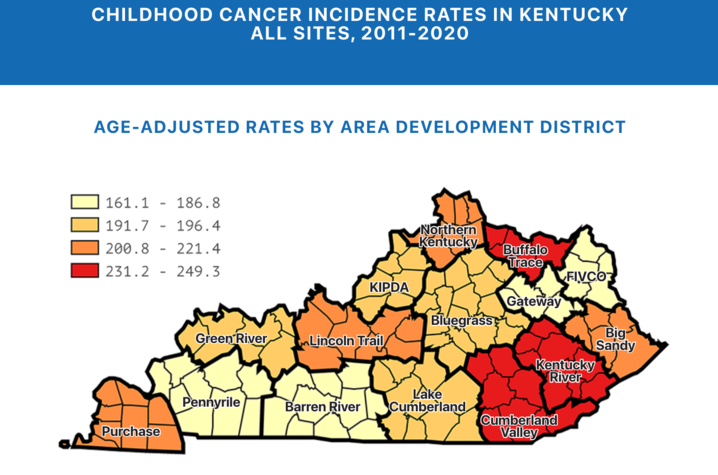Markey report reveals disparities in Kentucky’s childhood cancer rates
LEXINGTON, Ky. (June 14, 2024) — A new report from the University of Kentucky Markey Cancer Center’s Kentucky Cancer Registry (KCR) shows that Kentucky has higher rates of childhood cancer compared to the national average, with Appalachian counties experiencing an even greater burden.
The report, Childhood Cancer in Kentucky, aims to inform public health efforts to improve outcomes for children with cancer across the state.
“While childhood cancer is rare, it has a devastating impact on young patients and their families,” said Eric Durbin, Dr.P.H., director of the KCR and Cancer Research Informatics Shared Resource Facility at the UK Markey Cancer Center. “This report provides valuable data to guide prevention, treatment, and survivorship support efforts across the state.”
The report analyzed data from the KCR and other national registries from 2011 to 2020. During this 10-year period, 2,283 children under 20 in Kentucky were diagnosed with cancer. Leukemia, brain and nervous system tumors, lymphomas and skin cancers were the most frequently diagnosed cancer types.
The report shows that Kentucky's childhood cancer incidence rate is about 7.2% higher than the national rate. Kentucky’s childhood cancer incidence rates have also grown by over 1.78% annually between 2011 and 2019 — exceeding the national trend.
The report also found that compared to the rest of the U.S., children in Kentucky have a significantly higher risk of developing leukemia, brain and central nervous system tumors, lymphoma, skin cancers, sympathetic nervous system tumors, retinoblastoma and hepatic tumors.
The report also highlights significant geographic disparities within the state. Children in Appalachian Kentucky were more likely to be diagnosed with cancer than those in non-Appalachian Kentucky.
The report emphasizes the need for further research to understand the reasons behind these disparities and to develop targeted prevention and treatment strategies, particularly for children in Appalachia.
The complete Kentucky Childhood Cancer Incidence Report 2011-2020 can be accessed at https://www.kcr.uky.edu/childhood-report/.
KCR is part of the National Cancer Institute's Surveillance Epidemiology and End Results (SEER) program and the Centers for Disease Control and Prevention's National Program of Cancer Registries (NPCR).
Research reported in this publication was supported by the National Cancer Institute of the National Institutes of Health under Award Number HHSN261201800013I. The content is solely the responsibility of the authors and does not necessarily represent the official views of the National Institutes of Health.
This project is supported by the National Center for Chronic Disease Prevention and Health Promotion (NCCDPHP), Centers for Disease Control and Prevention of the U.S. Department of Health and Human Services (HHS) as part of a cooperative agreement totaling $1 million with 0% financed with non-governmental sources. The contents are those of the author(s) and do not necessarily represent the official views of, nor an endorsement, by NCCDPHP, CDC, HHS, or the U.S. Government. For more information, please visit www.cdc.gov/nccdphp.
As the state’s flagship, land-grant institution, the University of Kentucky exists to advance the Commonwealth. We do that by preparing the next generation of leaders — placing students at the heart of everything we do — and transforming the lives of Kentuckians through education, research and creative work, service and health care. We pride ourselves on being a catalyst for breakthroughs and a force for healing, a place where ingenuity unfolds. It's all made possible by our people — visionaries, disruptors and pioneers — who make up 200 academic programs, a $476.5 million research and development enterprise and a world-class medical center, all on one campus.





